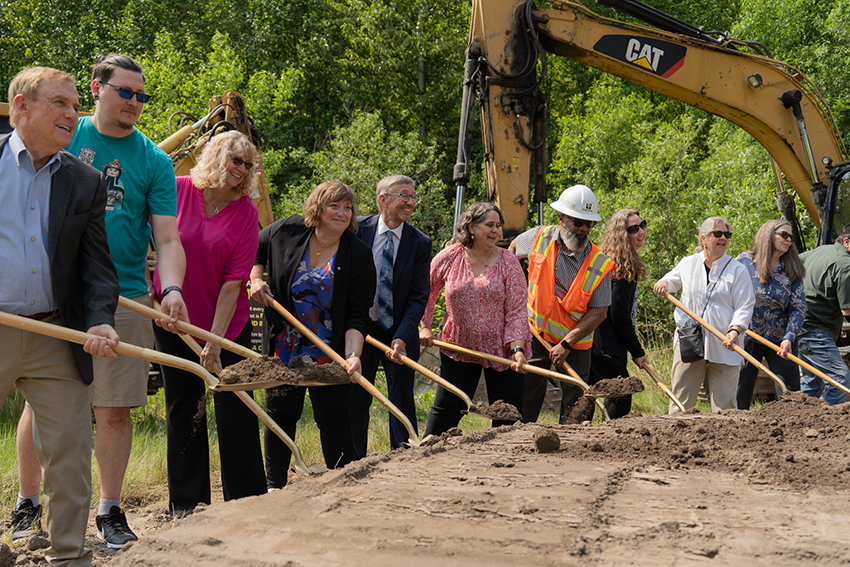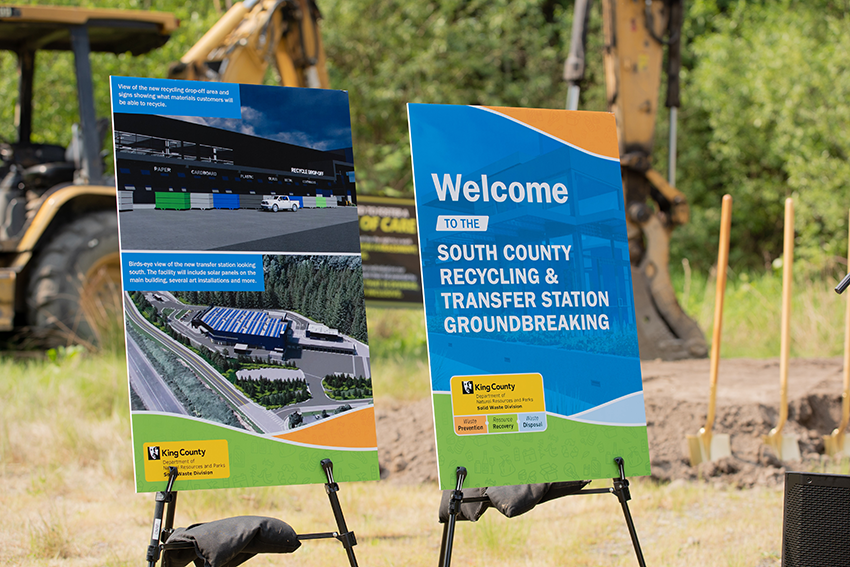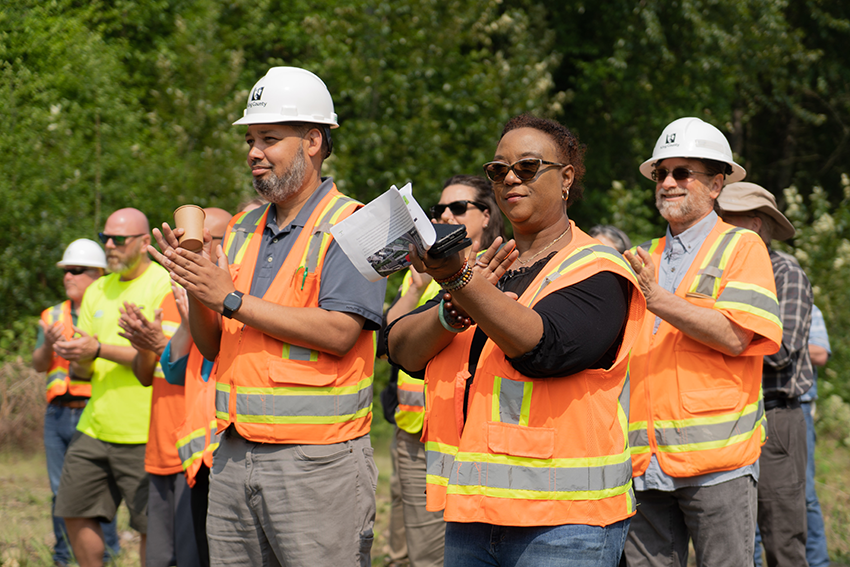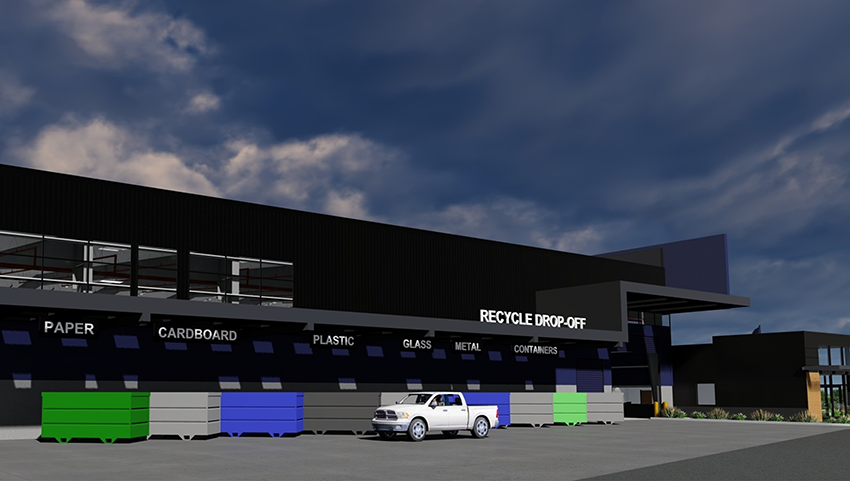Making it safer, easier for South King County to contribute to Re+ climate solutions: King County breaks ground on a state-of-the-art recycling station
Summary
King County broke ground on a state-of-the-art station in South King County that will offer enhanced waste disposal and recycling services, contributing to the Re+ initiative that will cut greenhouse gas emissions by reinventing the region’s waste system.
Story

King County broke ground on a state-of-the-art station in South King County that will offer enhanced waste disposal and recycling services, contributing to the Re+ initiative that will cut greenhouse gas emissions by reinventing the region’s waste system.
The new South County Recycling and Transfer Station in Algona – south of Auburn – will make it safer and easier to recycle appliances, glass, metals, plastics, wood, and paper, compost yard waste, and dispose hazardous materials. The green design includes a solar array that will provide nearly half of the energy needed to operate the station, charging stations for electric vehicles, and habitat enhancements.
The station – which was co-designed by the frontline employees who will operate it – is scheduled to open in 2026, replacing the 60-year-old Algona Transfer Station.
“Our modern station will make it safer and easier for the people of South King County to contribute to climate solutions by reducing waste,” said King County Executive Dow Constantine. “Our frontline employees helped design a state-of-the-art station that will improve the customer experience, enhance the surrounding environment, generate renewable energy, and offer a welcoming space for environmental education.”
Highlights
Full-length video
The $200 million station will advance the Re+ initiative to recover the estimated 70% of materials currently sent to Cedar Hills Regional Landfill that could have been reused, recycled, or composted. It will contribute to a goal established in King County’s Strategic Climate Action Plan to cut countywide greenhouse gas emissions in half by the end of the decade.
The new station will also feature waste compactors, which will cut greenhouse gas emissions by reducing the number of trips needed to haul materials to the regional landfill.
Operations employees participated in each meeting where function guided design. They contributed to how vehicles will flow through the station, the design of the transfer building, and its functions.
A modern station that improves habitat, protects water quality, reflects indigenous history
During the design phase, the Solid Waste Division partnered with Duwamish Infrastructure Restoration Training Corps, known as The DIRT Corps – an organization that provides green apprenticeship programs and environmental education. The partnership provided an eight-week paid professional training program focused on green stormwater infrastructure, restoring habitats, and installing rain gardens, all of which will improve the native landscape and build climate resiliency in the Green-Duwamish Watershed.
The station will include public art coordinated by 4Culture and developed by the Muckleshoot Indian Tribe’s Cultural Division artists – Sam Obrovac, Tyson Simmons, and Keith Stevenson – and Evan Blackwell, a visual artist and faculty member at The Evergreen State College. The Muckleshoot Indian Tribe’s site-responsive works will reflect ancestral teachings and highlight the surrounding natural environment. Blackwell’s art will draw upon engagement with the Solid Waste Division staff and neighboring community and will utilize natural materials from the project site.
The nearby Algona Transfer Station was built in the 1960s to provide garbage disposal services to households and businesses in an area that was just beginning to experience development. It is one of the smallest and oldest stations still in operation and lacks the space needed to provide even the most basic recycling services and does not offer hazardous waste disposal. The Solid Waste Division installed safety features to prevent customers from falling into the receptacle, which restricts the lengths of vehicles that can enter the station.
The new South County Recycling and Transfer Station is on track to earn Petal Certification from the International Living Future Institute. In addition to its sustainable construction, the new station will have a drought-tolerant landscape and be able to capture and use rainwater. The project will also restore natural systems, including realigning a stream so that it flows more in its natural path above ground rather than flowing through a pipe.
Images
Relevant links
- Project summary of South County Recycling and Transfer Station
- Re+
- PHOTO GALLERY: Groundbreaking ceremony
- VIDEO: Highlights from groundbreaking ceremony
- VIDEO: Full-length coverage of groundbreaking ceremony
- VIDEO: Reinventing the waste system, transitioning to a sustainable economy
- TRACKS: An interactive map of environmental stewardship
Quotes
Our modern station will make it safer and easier for the people of South King County to contribute to climate solutions by reducing waste. Our frontline employees helped design a state-of-the-art station that will improve the customer experience, enhance the surrounding environment, generate renewable energy, and offer a welcoming space for environmental education.
I am excited that construction is starting on the South County Recycling and Transfer Station. The apprenticeship programs and green jobs it will create are essential to a robust work force and to the long-term success of our region.
King County’s South County Recycling and Transfer Station will be a beacon for industrial facilities across the country and around the world. In a project type that most people see as only utilitarian, the County has shown true leadership, providing inspiration and proof that regenerative design is possible across any building type or scale.
In 2022, residents and small businesses properly disposed over 3.2 million pounds of hazardous waste in King County. People living and working in South King County must drive 30 minutes or more to reach a hazardous waste disposal site. The new facility in Algona brings easy, convenient disposal services much closer to home. We join our partners in upholding King County’s commitment to increase access to key services while protecting the health of our communities and the environment that we share.
For more information, contact:
Annie Kolb-Nelson, Solid Waste Division, 206-477-5373

 Translate
Translate



